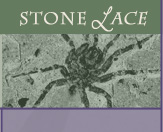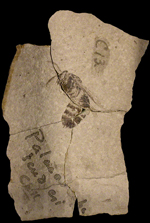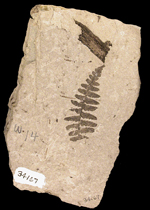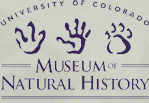 |
 |
||
Page 3 To view larger versions of the images below, click on a thumbnail image or the specimen name. The larger version will display in a new browser window. Use the page number links below the images to go to the next page or return to a previous page.  Palaeovespa scudderi, Common Name: Yellow Jacket or Hornet (UCM #4498). These wasps have that familiar yellow and black striped color-pattern on the abdomen. They build nest on trees, wooden structures and sometimes in the ground. Their nests consist of hexagonal cells of paper-like material. A queen will start a new colony each year. Larvae feed on other insects that the adults bring in for them. Palaeovespa scudderi, Common Name: Yellow Jacket or Hornet (UCM #4498). These wasps have that familiar yellow and black striped color-pattern on the abdomen. They build nest on trees, wooden structures and sometimes in the ground. Their nests consist of hexagonal cells of paper-like material. A queen will start a new colony each year. Larvae feed on other insects that the adults bring in for them. Dryopteris guyottii, Common Name: Wood Fern (UCM #34167). Modern Wood Ferns tend to live in places that reflect their common name, in wooded areas. Most species are found in temperate climates. This fern would have been quite similar in appearance to the ferns you buy today in the flower shop. Dryopteris guyottii, Common Name: Wood Fern (UCM #34167). Modern Wood Ferns tend to live in places that reflect their common name, in wooded areas. Most species are found in temperate climates. This fern would have been quite similar in appearance to the ferns you buy today in the flower shop. Carya florissantensis, Common Name: Hickory (Nut) (UCM #34333). From records of pollen, we know that ancestral species of Hickory trees were spread across North America prior to and during the Eocene. The Hickory Nut you see here is among the first readily recognizable fruit in this genus found in the fossil record. Hickory Nuts, with their strong outer shell, were often preserved in three dimensions at Florissant. This specimen is a mold of a fruit, showing details of the wrinkled shell. Carya florissantensis, Common Name: Hickory (Nut) (UCM #34333). From records of pollen, we know that ancestral species of Hickory trees were spread across North America prior to and during the Eocene. The Hickory Nut you see here is among the first readily recognizable fruit in this genus found in the fossil record. Hickory Nuts, with their strong outer shell, were often preserved in three dimensions at Florissant. This specimen is a mold of a fruit, showing details of the wrinkled shell. Eodiplurina cockerelli, Common Name: Mygalamorph spider (UCM #17703). Mygalamorph spiders are generally large bodied spiders and include groups like the tarantulas. They are ground-dwellers and live in silk-lined retreats. Primarily night predators, Mygalamorph spiders will feed on insects and small mammals, reptiles and birds. Although common in the western US, most Mygalamorphs are found in subtropical and tropical regions today. Eodiplurina cockerelli, Common Name: Mygalamorph spider (UCM #17703). Mygalamorph spiders are generally large bodied spiders and include groups like the tarantulas. They are ground-dwellers and live in silk-lined retreats. Primarily night predators, Mygalamorph spiders will feed on insects and small mammals, reptiles and birds. Although common in the western US, most Mygalamorphs are found in subtropical and tropical regions today. Aristolochia mortua, Common Name: Birthwort (UCM #18695). This leaf is part of a vine that grew near the ancient Lake Florissant nearly 34 million years ago. Modern species are native to Central and South America, but because of their strange and beautiful flowers, they can also be found growing in gardens all over the world. Its common name, Birthwort, comes from its use by some cultures as a pain killer during child birth. Aristolochia mortua, Common Name: Birthwort (UCM #18695). This leaf is part of a vine that grew near the ancient Lake Florissant nearly 34 million years ago. Modern species are native to Central and South America, but because of their strange and beautiful flowers, they can also be found growing in gardens all over the world. Its common name, Birthwort, comes from its use by some cultures as a pain killer during child birth. |

|
||
|
|
|||
|
|||
